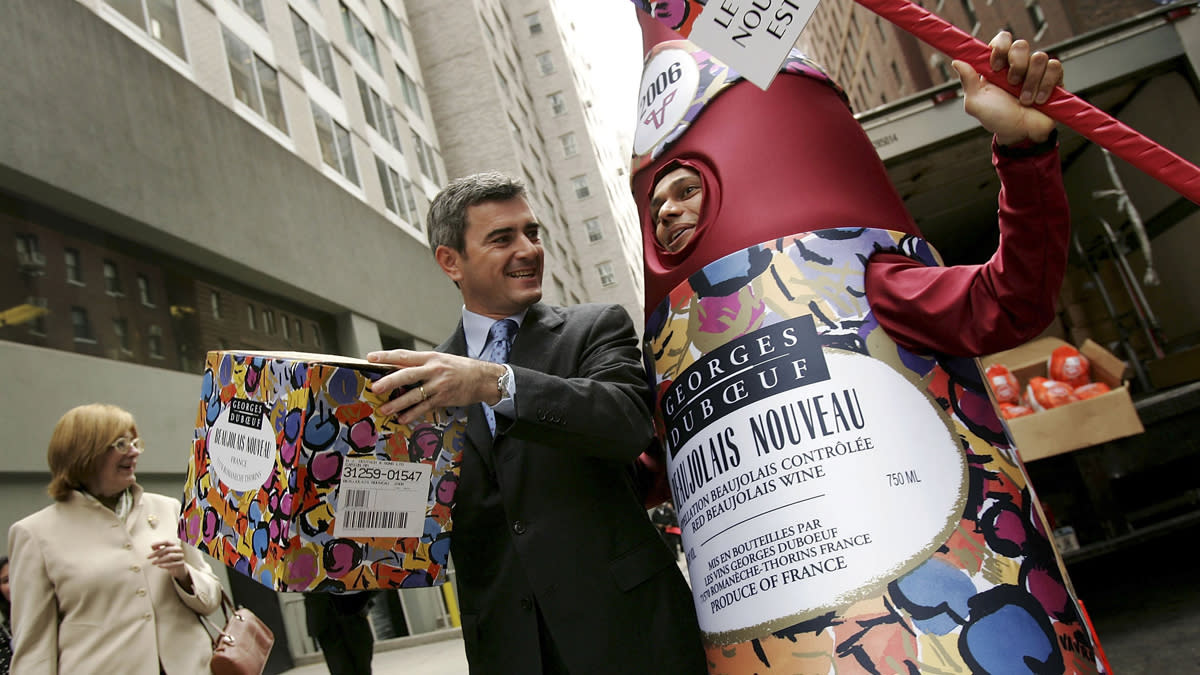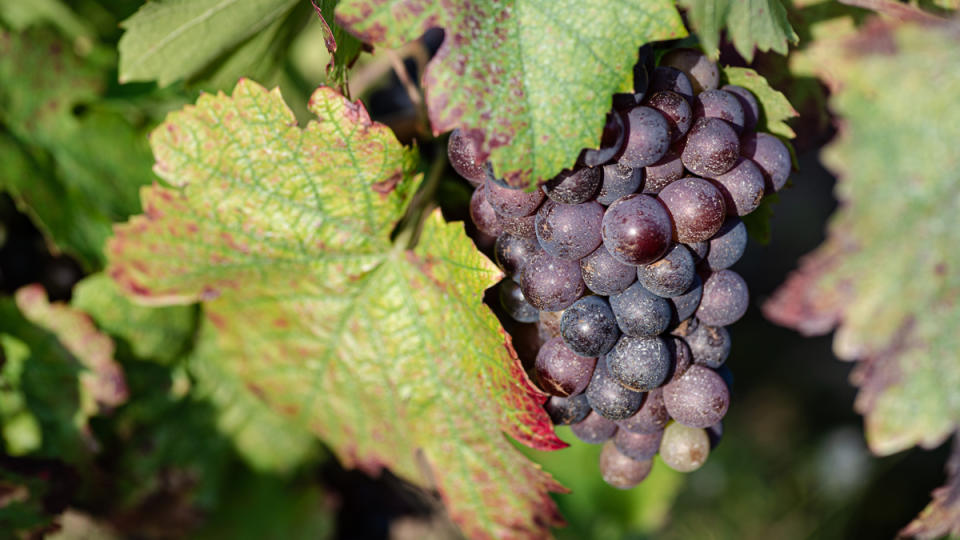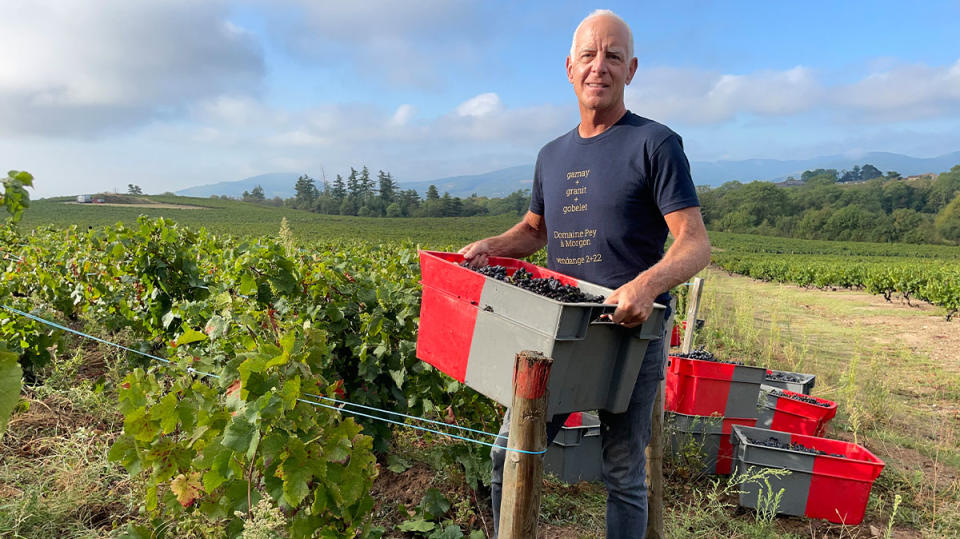Why It’s Time for You to Reconsider Beaujolais

This story is from an installment of The Oeno Files, our weekly insider newsletter to the world of fine wine. Sign up here.
Many wine drinkers’ lone reference point for Beaujolais is the barely drinkable plonk that arrives on our shores around Thanksgiving every year. Several readers may be checking the calendar right now to confirm the date because, unfortunately for the storied region nestled between Burgundy and the Rhône Valley, the only time that Beaujolais is normally mentioned coincides with the annual release of Beaujolais Nouveau on the third Thursday of November. Yet there is very little in common between that Beaujolais Nouveau and the more serious, oak-aged versions, especially from the 10 crus of Beaujolais. And if you’ve only experienced the former, we’re here to convince you to drink the latter.
More from Robb Report
Beaujolais wine is made with 100 percent Gamay, a grape native to France—most likely Burgundy—that is a natural cross between Pinot Noir and Gouais Blanc, a white grape that is nearly extinct but has left its mark on the wine world. That’s where the similarities between Beaujolais Nouveau and Beaujolais largely end; however, one has been allowed to sully the good name of the other.
Beaujolais’s poor reputation in America goes back to the 1980s, when Georges Duboeuf, a large producer in the region, expanded the French tradition of rushing just-fermented wine—only eight weeks after the harvest—into the market in Paris. What had begun as a quaint French tradition in the wake of WWII became an international marketing juggernaut, with wine shops and French restaurants across the United States displaying signs and banners announcing, “Le Beaujolais Nouveau Est Arrivé.” And people proclaimed this fresh and fruity style of red wine was the perfect match for Thanksgiving turkey, further cementing its place in the culture. While it’s still exciting to experience what’s known as Beaujolais Day at a wine bar in France, tasting several glasses and comparing various expressions from small producers, the United States was inundated with enormous volumes of generic juice from Duboeuf and a couple of other large wineries.

Julie Pitoiset, director and winemaker at Château des Jacques, explains that after the Second World War, “Beaujolais produced wines with a fruity style, with new techniques like carbonic maceration,” a modern fermentation method using carbon dioxide that’s associated with Beaujolais Nouveau. Unlike the barrel-aged wines that Pitoiset makes at Château des Jacques, wine released two months after the grapes have been picked has barely had enough time to ferment let alone settle and become well integrated. Pitoiset prefers to wait at least five years to open a bottle of her estate-grown wine from Morgon and Moulin-à-Vent—two of the region’s crus—and she says from a good season they can last in the bottle for 50 years or more.
The negativity around Gamay has deeper roots than the 1980s, reaching as far back as the Middle Ages. In 1395, Philip II, Duke of Burgundy, banned the cultivation of the variety in the region because its higher yields made it more valuable to wine merchants than fussier Pinot Noir, which was considered a nobler grape. When Gamay vines were ripped out in the Cote d’Or and replaced with Pinot Noir, Gamay found a new home farther south in Beaujolais. However, its troubles didn’t end with the conclusion of the 14th century, as it was further outlawed in 1455, 1567, and several times in the 1700s. As recently as 2011, 40 Beaujolais communes lost the ability to label some of their wines “Burgundy.” If it seems that poor Beaujolais can’t catch a break, its time may finally have come as Pinot Noir from its neighbor to the north becomes too expensive for many consumers, especially at restaurant markups, and as younger wine drinkers unfamiliar with its nouveau incarnation may not have an unfavorable impression of it.
At Chateau du Moulin-à-Vent, proprietor Edouard Parinet believes sommeliers, corporate buyers, and wine writers have an excellent opinion of Beaujolais, which sadly has not caught on with the wine-loving public. He thinks in the short term, at least, Beaujolais has a leg up on other regions as climate change ravages vineyards around the world. “Some of the best wines produced in Château du Moulin-à-Vent have been from the earliest and driest vintages ever,” he explains, adding that the region’s sandy soils, home to the chateau’s oldest vines, gives its wines “structure and power so they can last long.” A recent vertical tasting of its wines back to 1967 proved his claim; they had power, finesse, and elegance and still retained bright cherry and pomegranate flavors alongside spice and touches of earthiness. The same high acidity that makes young Beaujolais an easy-drinking winter libation aids in its ageability; older wines with limited acidity fall flat on the palate, a complete contrast to the vivid liveliness of the older vintages tasted.
While both Chateau du Moulin-à-Vent and Château des Jacques trace their roots to the 18th century, the eponymous Domaine Jonathan Pey has just released its first bottling, 2022 Morgon “Bellevue.” Jonathan Pey, the cofounder of Textbook in Napa Valley, explained to us that he was drawn to Beaujolais’s Morgon and Fleurie crus because of their pink-granite and schist soils, steep slopes, altitude, rich winemaking histories, and abundant rainfall. “After witnessing climate changes’ devastating effects—droughts, forest fires, and smoke [in California]—I decided to go for it,” he says, while pointing out the value it offers. “Morgon and Fleurie earned their coveted AOC cru status in 1936, the same year as Romanée-Conti and Pauillac. All these wines used to be similarly priced, so the pedigree of the tiny cru districts of Morgon and Fleurie is considerable.” Made from dry-farmed vines planted “when Truman was president,” this limited-production, hand-crafted wine sells for around $35 in the United States.

After spending years in Napa, Pey points out that working with Cabernet Sauvignon and Gamay are completely different, as opposed to the highly manipulated, long-aged style of winemaking that Cabernet often requires. “Gamay is often fermented briefly whole cluster or with some stems to add grip,” he says. “It has a cooler fermentation which captures aroma, texture, and vibrant fruit and typically does not see much oak barrel aging.”
Beaujolais’s 10 crus, from north to south, are St. Amour, Juliénas, Chénas, Moulin-à-Vent, Fleurie, Chiroubles, Morgon, Régnié, Côte de Brouilly, and Brouilly. Bottles from one of these villages will be labeled with its name rather than Beaujolais. The crus lie in the north of the region, just south of Burgundy’s Maconnais, and their rolling hills and stony soils produce the best examples of terroir-driven wines. Wines labeled Beaujolais Village are from 38 communes also located just south of here, while more generic AOC Beaujolais bottlings come from communes in the south of the region, which is flatter and has more clay in its vineyards. Expect aromas of cherry and raspberry and flavors of bright-red berries with notes of vanilla, spice, violet, and earthiness. Serve lightly chilled—say around 60 degrees Fahrenheit—in a Pinot Noir glass; if you don’t have a wine fridge, 20 minutes in the refrigerator will do. Pair with hard cheeses, roast or fried chicken, or grilled pork chops.
While not all Gamay is built for long-term aging, bottles will mature well for five to 10 years. Even the finest Beaujolais has a soft tannic structure that is perfect for warmer weather enjoyment. As Pitoiset pointed out, wine lovers are searching for vin de terroir with an eye on geographic origin and the environment. With many wineries engaged in organic or biodynamic farming, Beaujolais offers all of that. Producers to look out for include Guy Breton, Stéphane Aviron, Marcel Lapierre, Château Thivin, Mont Bessay, and, of course, those mentioned above. Whatever you do in your exploration of this underappreciated region, please don’t wait six months to just grab a barely fermented screw-capped bottle on your way to the in-laws and then plop it on the Thanksgiving table. Beaujolais deserves better than that.
Do you want access to rare and outstanding reds from Napa Valley? Join the Robb Report 672 Wine Club today.
Best of Robb Report
Why a Heritage Turkey Is the Best Thanksgiving Bird—and How to Get One
The 10 Best Wines to Pair With Steak, From Cabernet to Malbec
Sign up for Robb Report's Newsletter. For the latest news, follow us on Facebook, Twitter, and Instagram.

